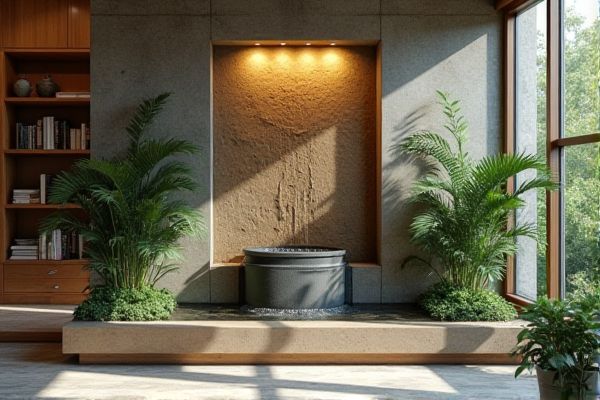
Wall fountains save space and create a striking vertical water feature by being mounted directly on a wall, ideal for smaller gardens or patios. Freestanding fountains offer flexibility in placement and become a central focal point in larger outdoor areas; explore the rest of the article to discover which fountain suits your space and style best.
Table of Comparison
| Feature | Wall Fountain | Freestanding Fountain |
|---|---|---|
| Installation | Mounted on a wall; requires sturdy support | Stands independently; needs flat surface |
| Space Requirement | Ideal for small spaces or narrow gardens | Needs more ground space; suitable for open areas |
| Design | Compact, vertical water flow | Varied styles; horizontal or vertical water flow |
| Water Capacity | Smaller basin; less water volume | Larger basin; higher water volume |
| Maintenance | Easier to clean due to accessible design | May require more effort depending on size |
| Mobility | Fixed to wall; not portable | Movable; can be relocated |
| Noise Level | Often quieter; gentle water sound | Varies; can be louder due to larger water flow |
| Cost | Generally less expensive | Typically higher cost depending on size and design |
Introduction to Wall vs Freestanding Fountains
Wall fountains save space by mounting directly onto walls, making them ideal for small patios or gardens. Freestanding fountains serve as bold centerpiece features, requiring more floor space and offering greater design versatility. Both provide soothing water sounds but differ in installation, size, and aesthetic impact.
Design and Aesthetic Considerations
Wall fountains save space by mounting directly onto your exterior or interior walls, offering a sleek, vertical design that complements modern and minimalist aesthetics. Freestanding fountains serve as bold centerpieces with three-dimensional shapes and intricate designs, enhancing garden or patio areas through their sculptural presence. Both options provide soothing water features, but your choice depends on available space and the desired visual impact in your landscaping or decor.
Space Requirements and Placement
Wall fountains require minimal floor space as they mount directly onto a vertical surface, making them ideal for small patios, balconies, or narrow garden areas. Freestanding fountains need ample room around all sides for proper visual impact and maintenance, making them better suited for larger gardens or open spaces. Your choice depends on available space and desired focal points in your outdoor area.
Installation Process and Complexity
Wall fountains require mounting onto a sturdy, waterproof surface with secure brackets and proper sealing, making installation more complex and labor-intensive. Freestanding fountains offer greater flexibility as they only need a stable base and access to power and water, allowing for easier and quicker setup without structural modifications. Choosing between the two depends on available space, wall strength, and desired complexity of the installation process.
Maintenance and Cleaning Needs
Wall fountains typically require less maintenance compared to freestanding fountains because their design limits water exposure and reduces debris buildup, allowing for easier cleaning of filters and surfaces. Freestanding fountains, exposed on all sides and often larger, demand more frequent cleaning to prevent algae growth, mineral deposits, and pump clogging, especially if placed outdoors. Selecting materials like fiberglass or resin for either type can further minimize upkeep by resisting corrosion and dirt accumulation.
Water Usage and Efficiency
Wall fountains typically use less water due to recirculating systems that minimize evaporation and reduce waste, making them more efficient for water savings. Freestanding fountains, while visually striking, often require larger water volumes to maintain continuous flow, increasing overall water consumption. Your choice should consider water efficiency if conserving resources is a priority.
Cost Comparison and Budget Factors
Wall fountains generally cost less than freestanding fountains due to simpler installation and smaller size, making them ideal for tighter budgets. Freestanding fountains involve higher expenses linked to larger materials, more complex plumbing, and potential landscaping adjustments. Your budget should account for ongoing maintenance costs, with wall fountains typically requiring less upkeep and energy.
Sound and Ambience Differences
Wall fountains create a gentle, cascading water sound that reflects off the structure, producing a soothing background noise ideal for small spaces and intimate settings. Freestanding fountains offer a more immersive auditory experience with water flowing from multiple directions, resulting in richer, dynamic soundscapes that enhance large gardens or patios. The choice between the two influences the overall ambiance, with wall fountains promoting subtle tranquility and freestanding fountains providing vibrant, natural white noise.
Durability and Material Options
Wall fountains typically feature durable materials such as natural stone, cast stone, and fiberglass, offering strong resistance to weather and corrosion when mounted securely against a structure. Freestanding fountains often present a wider array of material options including concrete, metal, ceramic, and resin, designed to withstand exposure on all sides but may require more maintenance due to their full exposure to elements. Both types emphasize durability but differ in structural support and material versatility, influencing longevity and maintenance based on environmental conditions.
Choosing the Right Fountain for Your Space
Wall fountains save space by mounting directly on a wall, ideal for small patios or gardens, offering vertical water features that enhance ambiance without occupying ground area. Freestanding fountains require floor space but provide sculptural presence and versatility in placement, suitable for larger open areas or focal points in landscapes. Selecting the right fountain involves assessing available space, desired aesthetic impact, and installation constraints to balance functionality with design preferences.
 homyna.com
homyna.com